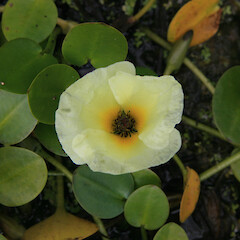Hydrocleys nymphoides
Common name
water poppy
Family
Limnocharitaceae
Flora category
Vascular – Exotic
Structural class
Herbs - Monocots
Conservation status
Not applicable
Brief description
Stoloniferous perennial with tufts of thick glossy, floating leaves attached to rubbery creeping stems and a distinctive showy yellow flowers with a purple centre.
Distribution
Locally naturalised in northern North Island south to the Rotorua lakes, eradicated from most known sites.
Habitat
Still and flowing water bodies, including ponds, streams and lake margins to ca 2m water depth.
Wetland plant indicator status rating
Information derived from the revised national wetland plant list prepared to assist councils in delineating and monitoring wetlands (Clarkson et al., 2021 Manaaki Whenua – Landcare Research Contract Report LC3975 for Hawke’s Bay Regional Council). The national plant list categorises plants by the extent to which they are found in wetlands and not ‘drylands’. The indicator status ratings are OBL (obligate wetland), FACW (facultative wetland), FAC (facultative), FACU (facultative upland), and UPL (obligate upland). If you have suggestions for the Wetland Indicator Status Rating, please contact: [Enable JavaScript to view protected content]
OBL: Obligate Wetland
Almost always is a hydrophyte, rarely in uplands (non-wetlands).
Detailed description
Underwater stem is elastic, creeping, or floating near the water surface. Leaves and roots attached at each node along the stem. Leaves are bright glossy green, oval, 7 cm long, and have an inflated main vein on the underside. The leaf sinus is shallow. Flowers consist of 3 yellow petals with a purple centre (filaments) and are up to 8 cm across.
Similar taxa
Yellow water lily (Nuphar lutea), marshwort (Nymphoides geminata), and fringed water lily (Nymphoides peltata). Yellow water lily has very thick spongy stolons (up to 10 cm) and much larger floating leaves (up to 40 cm long and 30 cm wide). Marshwort and fringed water lily do not have an inflated mid-vein on the underside of the leaves. They also have wings on the outer edges of their petals.
Flowering
Late summer
Flower colours
Purple, Yellow
Fruiting
No seed production known in NZ
Life cycle
Vegetative spread by stolon fragments, deliberate planting.
Water poppy produces new plantlets at the end of the growth season. These break away from the main plant and rise to the surface, where they are carried away by water movement to a new location before taking root in the mud (Ermert & Clapp 1998)
Year naturalised
1914
Origin
Tropical South America.
Reason for introduction
Ornamental pond plant
Control techniques
Notify regional council if found
National Pest Plant Accord species
This plant is listed in the 2020 National Pest Plant Accord. The National Pest Plant Accord (NPPA) is an agreement to prevent the sale and/or distribution of specified pest plants where either formal or casual horticultural trade is the most significant way of spreading the plant in New Zealand. For up to date information and an electronic copy of the 2020 Pest Plant Accord manual (including plant information and images) visit the MPI website.
Attribution
Factsheet prepared by Paul Champion and Deborah Hofstra (NIWA).
References and further reading
Champion et al (2012). Freshwater Pests of New Zealand. NIWA publication. http://www.niwa.co.nz/freshwater-and-estuaries/management-tools/identification-guides-and-fact-sheets/freshwater-pest-species.
Coffey BT, Clayton JS (1988). New Zealand water plants: a guide to plants found in New Zealand freshwaters. Ruakura Agricultural Cente. 65pp.
Johnson PN, Brooke PA (1989). Wetland plants in New Zealand. DSIR Field Guide, DSIR Publishing, Wellington. 319pp.
Kasselmann C (2003). Aquarium plants. Krieger Publishing company, Florida, 518pp.;





